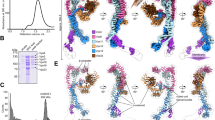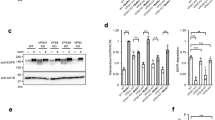Abstract
The eukaryotic cell is defined by a complex set of sub-cellular compartments that include endomembrane systems making up the exocytic and endocytic trafficking pathways. Current evidence suggests that both the function and communication between these compartments are regulated by distinct families of proteins that direct membrane fission, targeting and fusion. These families include coat protein complexes (CPCs) involved in vesicle formation/fission, Rab GTPases involved in vesicle targeting, and soluble Af-ethyl-maleimide-sensitive factor attachment protein receptors (SNAREs) involved in vesicle fusion. The origins of these gene families and their individual contributions to the evolutionary specialization of the membrane architectures of lower and higher eukaryotes are now better understood with the advent of powerful phylogenetic, structural and systems biology tools. Herein, we provide a perspective that suggests that while the core CPC and SNARE machineries have diversified modestly in the course of eukaryotic evolution, the Rab GTPase family expanded substantially to emerge as a key driving force in endomembrane specialization. The Rab GTPases appear to have provided the foundation for the intricate membrane architectures ranging from those requisite for the distinct amoebic life cycle stage of uni-cellular organisms such as the parasitic protozoa to the highly specialized tissue and cell type-specific endomembranes of multi-cellular eukaryotes. We propose that Rab-centric interaction networks orchestrate the divergent activities of fission and fusion through their capacity to cntrol the sequential assembly of protein complexes that mediate endomembrane structure and communication.
Access this chapter
Tax calculation will be finalised at checkout
Purchases are for personal use only
Preview
Unable to display preview. Download preview PDF.
Similar content being viewed by others
References
Cavalier-Smith T. The phagotrophic origin of eukaryotes and phylogenetic classification of Protozoa. Int J Syst Evol Microbiol 2002; 52(Pt 2):297–354.
Mans BJ, Anantharaman V, Aravind L et al. Comparative genomics, evolution and origins of the nuclear envelope and nuclear pore complex. Cell Cycle 2004; 3(12): 1612–1637.
Blobel G. Intracellular protein topogenesis. Proc Natl Acad Sci USA 1980; 77(3):l496–1500.
Jekely G. Small GTPases and the evolution of the eukaryotic cell. Bioessays 2003; 25(11):1129–1138.
Colicelli J. Human RAS superfamily proteins and related GTPases. Sci STKE 2004; 2004(250):RE13.
Gurkan C, Lapp H, Alory C et al. Large-scale profiling of Rab GTPase trafficking networks: The membrome. Mol Biol Cell 2005; 16(8):3847–3864.
Donaldson JG, Honda A. Localization and function of Arf family GTPases. Biochem Soc Trans 2005; 33(Pt 4):639–642.
Bock JB, Matern HT, Peden AA et al. A genomic perspective on membrane compartment organization. Nature 2001; 409(6822):839–841.
Lee MC, Orci L, Hamamoto S et al. Sarlp N-terminal helix initiates membrane curvature and completes the fission of a COPII vesicle. Cell 2005; 122(4):605–617.
Aridor M, Fish KN, Bannykh S et al. The Sari GTPase coordinates biosynthetic cargo selection with endoplasmic reticulum export site assembly. J Cell Biol 2001; 152(l):213–229.
Pereira-Leal JB, Seabra MC. The mammalian Rab family of small GTPases: Definition of family and subfamily sequence motifs suggests a mechanism for functional specificity in the Ras superfamily. J Mol Biol 2000; 301(4): 1077–1087.
Pereira-Leal JB, Seabra MC. Evolution of the Rab family of small GTP-binding proteins. J Mol Biol 2001; 313(4):889–901.
Hong W. SNAREs and traffic. Biochim Biophys Acta 2005; 1744(2): 120–144.
Gurkan C, Lapp H, Hogenesch J et al. Exploring trafficking GTPase function by mRNA expression profiling: Use of the SymAtlas web-application and the membrome datasets. Methods Enzymol 2005; 403:1–10.
Lee MC, Miller EA, Goldberg J et al. Bi-directional protein transport between the ER and Golgi. Annu Rev Cell Dev Biol 2004; 20:87–123.
McMahon HT, Mills IG. COP and clathrin-coated vesicle budding: Different pathways, common approaches. Curr Opin Cell Biol 2004; 16(4):379–391.
Schledzewski K, Brinkmann H, Mendel RR. Phylogenetic analysis of components of the eukaryotic vesicle transport system reveals a common origin of adaptor protein complexes 1, 2, and 3 and the F subcomplex of the coatomer COPI. J Mol Evol 1999; 48(6):770–778.
Hoffman GR, Rahl PB, Collins RN et al. Conserved structural motifs in intracellular trafficking pathways: Structure of the gammaCOP appendage domain. Mol Cell 2003; 12(3):615–625.
Eugster A, Frigerio G, Dale M et al. COP I domains required for coatomer integrity, and novel interactions with ARF and ARF-GAP. Embo J 2000; 19(15):3905–3917.
Devos D, Dokudovskaya S, Alber F et al. Components of coated vesicles and nuclear pore complexes share a common molecular architecture. PLoS Biol 2004; 2(12):e380.
Hartzell PL. Complementation of sporulation and motility defects in a prokaryote by a eukaryotic GTPase. Proc Natl Acad Sci USA 1997; 94(18):9881–9886.
Matsuoka K, Orci L, Amherdt M et al. COPII-coated vesicle formation reconstituted with purified coat proteins and chemically defined liposomes. Cell 1998; 93(2):263–275.
Bi X, Corpina RA, Goldberg J. Structure of the Sec23/24-Sarl prebudding complex of the COPII vesicle coat. Nature 2002; 419(6904):271–277.
Owen DJ, Collins BM, Evans PR. Adaptors for clathrin coats: Structure and function. Annu Rev Cell Dev Biol 2004; 20:153–191.
Robinson MS. Adaptable adaptors for coated vesicles. Trends Cell Biol 2004; 14(4): 167–174.
Ellenberg J, Siggia ED, Moreira JE et al. Nuclear membrane dynamics and reassembly in living cells: Targeting of an inner nuclear membrane protein in interphase and mitosis. J Cell Biol 1997; 138(6):1193–1206.
Siniossoglou S, Lutzmann M, Santos-Rosa H et al. Structure and assembly of the Nup84p complex. J Cell Biol 2000; 149(l):41–54.
Siniossoglou S, Wimmer C, Rieger M et al. A novel complex of nucleoporins, which includes Secl3p and a Secl3p homolog, is essential for normal nuclear pores. Cell 1996; 84(2):265–275.
Schwartz TU. Modularity within the architecture of the nuclear pore complex. Curr Opin Struct Biol 2005; 15(2):221–226.
Jekely G. Glimpsing over the event horizon: Evolution of nuclear pores and envelope. Cell Cycle 2005; 4(2):297–299.
Ungar D, Hughson FM. SNARE protein structure and function. Annu Rev Cell Dev Biol 2003; 19:493–517.
Fasshauer D, Sutton RB, Brunger AT et al. Conserved structural features of the synaptic fusion complex: SNARE proteins reclassified as Q-and R-SNAREs. Proc Natl Acad Sci USA 1998; 95(26):15781–15786.
Gerst JE. SNARE regulators: Matchmakers and matchbreakers. Biochim Biophys Acta 2003; l64l(2–3):99–110.
Deneka M, Neeft M, van der Sluijs P. Regulation of membrane transport by rab GTPases. Crit Rev Biochem Mol Biol 2003; 38(2):121–142.
Zerial M, McBride H. Rab proteins as membrane organizers. Nat Rev Mol Cell Biol 2001; 2(2):107–117.
Alory C, Balch WE. Molecular basis for Rab prenylation. J Cell Biol 2000; 150(l):89–103.
Alory C, Balch WE. Organization of the Rab-GDI/CHM superfamily: The functional basis for choroideremia disease. Traffic 2001; 2(8):532–543.
Spang A. Vesicle transport: A close collaboration of Rabs and effectors. Curr Biol 2004; l4(l):R33–34.
Bernards A. GAPs galore! A survey of putative Ras superfamily GTPase activating proteins in man and Drosophila. Biochim Biophys Acta 2003; l603(2):47–82.
Saito-Nakano Y, Loftus BJ, Hall N et al. The diversity of Rab GTPases in Entamoeba histolytica. Exp Parasitol 2005; 110(3):244–252.
Lal K, Field MC, Carlton JM et al. Identification of a very large Rab GTPase family in the parasitic protozoan Trichomonas vaginalis. Mol Biochem Parasitol 2005; 143(2):226–235.
Pfeffer SR. Rab GTPases: Specifying and deciphering organelle identity and function. Trends Cell Biol 2001; 11(12):487–491.
Pfeffer SR. Structural clues to Rab GTPase functional diversity. J Biol Chem 2005; 280(16):15485–15488.
Fukuda M. Versatile role of Rab27 in membrane trafficking: Focus on the Rab27 effector families. J Biochem (Tokyo) 2005; 137(1):9–16.
Futter CE, Ramalho JS, Jaissle GB et al. The role of Rab27a in the regulation of melanosome distribution within retinal pigment epithelial cells. Mol Biol Cell 2004; 15(5):2264–2275.
Gibbs D, Azarian SM, Lillo C et al. Role of myosin VIIa and Rab27a in the motility and localization of RPE melanosomes. J Cell Sci 2004; 117(Pt 26):6473–6483.
Matsuoka K, Schekman R, Orci L et al. Surface structure of the COPII-coated vesicle. Proc Nad Acad Sci USA 2001; 98(24):13705–13709.
Dumas JJ, Zhu Z, Connolly JL et al. Structural basis of activation and GTP hydrolysis in Rab proteins. Structure Fold Des 1999; 7(4):413–423.
Author information
Authors and Affiliations
Corresponding author
Rights and permissions
Copyright information
© 2007 Landes Bioscience and Springer Science+Business Media
About this chapter
Cite this chapter
Gurkan, C., Koulov, A.V., Balch, W.E. (2007). An Evolutionary Perspective on Eukaryotic Membrane Trafficking. In: Eukaryotic Membranes and Cytoskeleton. Advances in Experimental Medicine and Biology, vol 607. Springer, New York, NY. https://doi.org/10.1007/978-0-387-74021-8_6
Download citation
DOI: https://doi.org/10.1007/978-0-387-74021-8_6
Publisher Name: Springer, New York, NY
Print ISBN: 978-0-387-74020-1
Online ISBN: 978-0-387-74021-8
eBook Packages: Biomedical and Life SciencesBiomedical and Life Sciences (R0)




